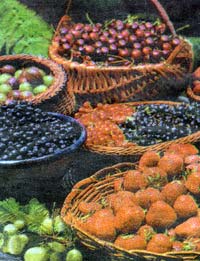
|
Cell-Cleansing Clusters
Apart from providing plenty of vitamin C
Athens News Walking through the Greek countryside in autumn. One is likely to come across a variety of berries, either growing wild or making up part of a long-abandoned fence. Fruits like these must have been eaten by our earlier ancestors. At the Middle Pleistocene site of Choukoutien in China, Peking Man – the Far Eastern variety of Homo erectus – was obviously using blackberries (Celtis sinensis), known as ‘senoki’ in English. A layer of broken shells several inches thick was found there. Closer to home, at the Neolithic Swiss lake-site of Glastonbury, seeds of a large variety of berries were discovered, including (among others) the blackberry, common and dwarf elder berry, cornel cherry, dewberry, dog-rose berry, hawthorn berry, raspberry and strawberry. The strawberry was the rarest, the wayfaring tree berry the commonest. The genus Rubus comprises about 100 species, and eight of these account for the majority of Greece’s wild berries. Characteristically, each berry consists of a cluster of tinier ‘berries’. One (R tomentosus) is probably the hamaivatos of Theophrastus. Another (R fruticosus or ulmifolius) is the vatos par excellence of the ancient Greeks, the common thorny bush known as blackberry in English. This berry is indeed often black or very dark purple, and closely resembles another species of the same genus, the raspberry. The blackberry bush, in many varieties, grows wild but it is also cultivated widely almost everywhere in Europe, a good part of Asia, and in North Africa. In continental Greece the anatolicus variety is most common, while in Cyprus it is Sanctus. Other species include the Virginia raspberry (a native of North America) and the cloudberry, which grows wild in northwestern Europe. Other varieties from there include the dewberry, the raspberry and the famous framboise of the French, used for a variety of sweets and ice creams, its sweet and tart flavor often inciting our taste-buds to shameful excesses. These last two are also seen wild in mountainous areas of Greece, and the raspberry appears to be the vatos idaia of Dioskorides, who thought the plant was native to Phrygia. In North America blackberries are divided into those that grow on brambles, and those that burgeon on trailing vines. The latter are often called dewberries in the southern states. Between them, these two varieties constitute the major commercially exploited crops of wild berries. Because of the delicacy of berries, hybrids have been produced by crossing blackberries and raspberries, giving us such varieties as Loganberries, Marionberries, and Youngberries, and the large deep purple Boysenberries, developed by Rudolph Boysen of Napa, California in the 1920s. They are all autumn crops and appear to have been used medicinally by native Americans, reputedly as good “blood cleansers” and as aids against dysentery and common colds. Their leaves were also good for sore throats. All these are hardly old wives’ tales. Apart from their content of Vitamin C, iron, potassium etc, blackberries are an excellent source of bioflavonoids, anthocyanidins and other powerful natural antioxidants. They are also some of the tastiest and best side-effect-free medications against chronic degenerative diseases – the scourge of our society and age. So, if you have the opportunity, eat as many blackberries (and other berries mentioned above) as you can, preferably picked away from busy roads. The idea is to use the antioxidants of berries to prevent or slow down the degeneration of your cells, not to fight the heavy metals you may swallow together with the berries. Recipes Blackberry fluffy dessert |
|

